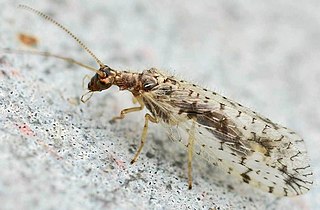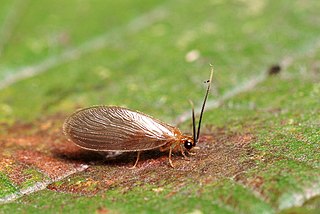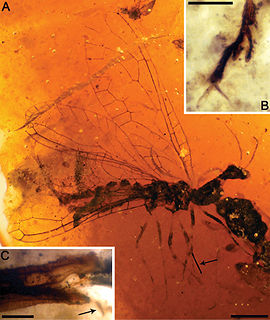
Hemerobiidae is a family of Neuropteran insects commonly known as brown lacewings, comprising about 500 species in 28 genera. Most are yellow to dark brown, but some species are green. They are small; most have forewings 4–10 mm long. These insects differ from the somewhat similar Chrysopidae not only by the usual coloring but also by the wing venation: hemerobiids differ from chrysopids in having numerous long veins and forked costal cross veins. Some genera are widespread, but most are restricted to a single biogeographical realm. Some species have reduced wings to the degree that they are flightless. Imagines (adults) of subfamily Drepanepteryginae mimic dead leaves. Hemerobiid larvae are usually less hairy than chrysopid larvae.

Sisyridae, commonly known as spongeflies or spongillaflies, are a family of winged insects in the order Neuroptera. There are approximately 60 living species described, and several extinct species identified from the fossil record.
Microberotha is an extinct monotypic genus of "beaded lacewing" in the family Berothidae known from a fossil found in North America. When described the genus contained a single Ypresian-age species Microberotha macculloughi.

Allorapisma is an extinct genus of lacewing in the moth lacewings family Ithonidae. The genus is solely known from two Eocene fossils found in North America. At the time of description the genus was composed of a single species, Allorapisma chuorum.

Undulopsychopsis is an extinct genus of lacewing in the silky lacewing family Psychopsidae. The genus is solely known from a Cretaceous fossil found in China. Currently the genus is composed of a single species, Undulopsychopsis alexi.

Amarantoraphidia is an extinct genus of snakefly in the family Mesoraphidiidae. The genus is solely known from Early Cretaceous, Albian age, fossil amber found in Spain. Currently the genus comprises only a single species Amarantoraphidia ventolina.
Principiala is an extinct genus of lacewing in the moth lacewings family Ithonidae. The genus is known from Cretaceous fossils found in South America, Europe, and possibly Asia. The genus is composed of two species, the type species Principiala incerta, and Principiala rudgwickensis.
Makarkinia is an extinct genus of lacewings in the family Kalligrammatidae described by Martins-Neto in 1997 from fossils found in the Crato Formation of the Araripe Basin in northeastern Brazil. The genus contains two species dating to the Late Aptian, Makarkinia adamsi and Makarkinia kerneri.
Araripenymphes is an extinct genus of lacewing in the family Nymphidae known from fossils found in the Crato Formation of the Araripe Basin in South America. The genus contains a single species, Araripenymphes seldeni. The genus was named after the basin.
Rafaelnymphes is an extinct genus of lacewing in the family Nymphidae known from a fossil found in South America. The genus contains a single species, Rafaelnymphes cratoensis.
Burmaleon is an extinct genus of lacewing in the family Osmylidae known from fossils found in Asia. The genus contains a single species, Burmaleon magnificus.

Gerontoformica is an extinct genus of stem-group ants. The genus contains thirteen described species known from Late Cretaceous fossils found in Asia and Europe. The species were described between 2004 and 2016, with a number of the species formerly being placed into the junior synonym genus Sphecomyrmodes.

Camelomecia is an extinct genus of stem-group ants not placed into any Formicidae subfamily. Fossils of the single known species, Camelomecia janovitzi, are known from the Middle Cretaceous of Asia. The genus is one of several ants described from Middle Cretaceous ambers of Myanmar.

Baikuris is an extinct genus of ant in the Formicidae subfamily Sphecomyrminae, and is currently placed in the tribe Sphecomyrmini. The genus contains four described species: the type species Baikuris mandibularis, along with Baikuris casei, Baikuris maximus, and Baikuris mirabilis.
Paradoxosisyra is an extinct genus of lacewing in the spongefly family, Sisyridae. The genus contains a single species, Paradoxosisyra groehni and is placed into the extinct subfamily Paradoxosisyrinae. Paradoxosisyra is known from a solitary Middle Cretaceous fossil which was found in Asia.

Dlusskyidris is an extinct genus of ant in the Formicidae subfamily Sphecomyrminae, and is one of the five genera placed in the tribe Sphecomyrmini. The genus contains a single described species, Dlusskyidris zherichini, and is known from three Late Cretaceous fossils which have been found in northern Russia.
This list of fossil insects described in 2019 is a list of new taxa of fossil insects that are scheduled to be described during the year 2019, as well as other significant discoveries and events related to insect paleontology that are scheduled to occur in the year 2019.
This list of fossil insects described in 2017 is a list of new taxa that were described during the year 2017, as well as other significant discoveries and events related to insect paleontology that are scheduled to occur in the year 2017.
This list of fossil insects described in 2016 is a list of new taxa that were described during the year 2016, as well as other significant discoveries and events related to insect paleontology that are scheduled to occur in the year 2016.

Dipteromantispidae is an extinct family of neuropterans known from the Cretaceous period. Unlike other neuropterans, the family possesses only a single set of fully developed forewings, with the hindwings reduced to haltere like structures. They are generally small in size and possess raptorial forelegs. They are considered to belong to Mantispoidea, with an uncertain position within the clade.









